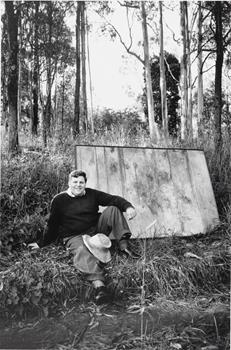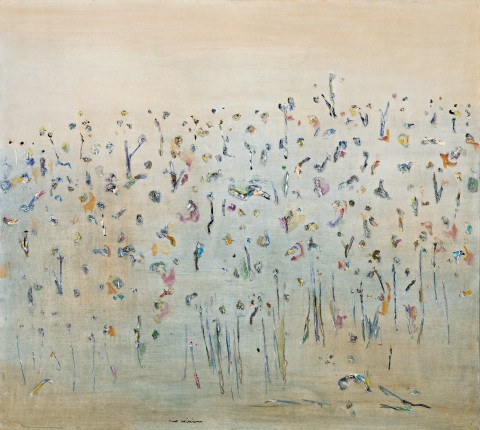HILLSIDE AT LYSTERFIELD II, 1967
FRED WILLIAMS
oil on canvas
137.5 x 153.0 cm
signed lower centre: Fred Williams
The Estate of Fred Williams, Melbourne
Lyn Williams, Melbourne
Deutscher~Menzies, Melbourne,1 May 2002, lot 30 (illus. front cover)
Private collection, Sydney
Deutscher and Hackett, Sydney, 1 September 2010, lot 15
Private collection, Perth
Fred Williams: a retrospective, National Gallery of Australia, Canberra, 7 November 1987 –31 January 1988; National Gallery of Victoria, Melbourne, 17 February - 3 April 1988; Tasmanian Museum and Art Gallery, Hobart, 18 April – 22 May 1988; Art Gallery of Western Australia, Perth, 13 June – 31 July 1988; Art Gallery of South Australia, Adelaide, 16 August – 30 October 1988;
Queensland Art Gallery, Brisbane, 24 November 1988 – 30 January 1989; Museums and Art Galleries of the Northern Territory, Darwin, 29 April – 4 June 1989; Art Gallery of New South Wales, Sydney, 8 August - 24 September 1989, cat. 82
Mollison, J., A Singular Vision: The Art of Fred Williams, Australian National Gallery, Canberra, 1989, pp. 102, 105 (illus.)
Hillside Landscape, 1966, oil on canvas, 134.5 x 142.5 cm, collection of News Corporation
Hillside at Lysterfield I, 1967, oil on canvas, 111.8 x 127.0 cm, private collection
Lysterfield Triptych, 1967–68, oil on three canvases, 152.5 x 122.0 cm, 152.5 x 183.5, 152.5 x 122.0 cm, collection of the National Gallery of Australia, Canberra
The 1960s began optimistically for Fred Williams. In 1963 he was invited to join the stable of artists represented by Sydney art dealer, Rudy Komon, and the monthly retainer he received gave Williams and his wife, Lyn, the financial confidence to buy a house at Upwey in the Dandenong Ranges. That same year Williams was awarded the Helena Rubinstein Travelling Art Scholarship, spending seven months in Europe in 1964. The following year was also significant – ‘for the first time [Williams] was able to paint full-time. The concentration and energy, and the time he now brought to his art, resulted in four years of astonishing variety and contrast in his painting.’1
From the beginning of his career Williams drew on his experience of the surrounding world as the source of subject matter for his art and the landscape of Upwey naturally featured in his paintings at this time. From mid-1965, nearby Lysterfield, which was just a short drive from his home, became a regular destination for outdoor painting trips. James Mollison, the artist’s great friend, described the area at the time as ‘sparsely settled country, with gently rolling hills and scrubby paddocks – fenced, but otherwise showing few signs of habitation’2, the perfect subject for an artist who used his immediate surroundings as a jumping off point for images which distilled the landscape to its essential elements, and in the process, created archetypal images which have become part of our collective visual memory.
Hillside at Lysterfield II and its counterpart, Hillside at Lysterfield I, are revealing in terms of what they tell us about Williams’ way of working. Painted in May and March of 1967 respectively, this pair highlights Williams’ observation of the changing seasons (and sometimes, different times of day) and how this transition was manifested in variations of colour. The dusky tones of Williams’ first view give way to the light-infused Hillside at Lysterfield II, where daubs of pink, turquoise, ochre and white sit upon a luminous ground. The horizon line that separates the hillside from the sky in the first version has been omitted in the second, as Williams moves towards an increasingly spare depiction of the landscape in a familiar pattern that saw him repeatedly move between representation and abstraction in his art. These images also highlight the important connection between painting and printmaking in Williams’ practice, where his work in one medium influenced developments in the other, and vice versa. The 1965-66 etching, Hillside at Lysterfield (Mollison 239), is closely related to the composition of our painting, and the similarity between some of the etched and engraved lines with those in the painting, suggests he referred to it when working on the canvas in the studio. The hieroglyphic-like marks that Williams used to describe the tall foreground grasses, the scrubby growth across the hillside, and the trees lining the horizon, are distinctively his, and typical of what Patrick McCaughey described as ‘his refined method of painting’ which was by this time, ‘as spontaneous as handwriting.’3
1. McCaughey, P., Fred Williams 1927 – 1982, Murdoch Books, Sydney, revised edition, 1996, p. 166
2. Mollison, J., Fred Williams: A Singular Vision, Australian National Gallery & Oxford University Press, Canberra, 1989, p. 100
3. McCaughey, op. cit., p. 184
KIRSTY GRANT
FRED WILLIAMS IN THE BUSH GARDEN AT UPWEY, 1963.jpg

Fred Williams is rightfully acclaimed as one of Australia's finest artists of the twentieth century. As a landscape painter he has no equal, Hillside at Lysterfield II, 1967 being one of a number of masterpieces that gives him that honour. His solo exhibition at Georges Gallery, Melbourne in the spring of 1967 opened to great applause. The art critics enthused. Patrick McCaughey in The Age declared that Williams 'has established himself as the most exciting landscape painter in Australia, and for sheer originality of vision Williams stands quite apart in Australian painting.’1 Alan McCulloch of the Melbourne Herald said that 'A truly revolutionary spirit can be found in Fred Williams' superb landscapes at Georges.’2 In recollection, these comments effectively recall the excitement, quality and impact Williams' work had at the time. We were witnessing the emergence of a brilliant new star in the heavens of Australian art, and the range of oil paintings and gouaches in this exhibition were unforgettable. Covering the few years from 1965 to 1967, the show included You-Yang landscapes, an Upwey painting already in the collection of Mr and Mrs Gordon Darling, with Mark Besen, Rudy Komon and the Reserve Bank of Australia among the other lenders. Rupert Murdoch had acquired Hillside Landscape Lysterfield, 1966-67, and Lysterfield Landscape II, 1967 went into the collection of Sir Roderick and Lady Carnegie. Lysterfield inspired Williams to further heights such as the large Triptych Landscape, 1967-68 in the collection of the National Gallery of Australia, Canberra. And Geelong Art Gallery's Yellow Landscape, 1968-69, has been described by McCaughey as 'the crowning glory of the whole Lysterfield group...’3
'At Lysterfield' as his close friend James Mollison points out, 'he often had to paint from the edge of the road, and tall foreground grasses are the key to many of his Lysterfield paintings.’4 These vertical signature marks are the key to these superb paintings, seen in Hillside at Lysterfield I,1967 and our painting. Both developed out of Hillside Landscape, 1966 in the collection of News Corporation.5 Hillside at Lysterfield I was painted in March with 'yellow & lilac everywhere'.6 Lysterfield Landscape II is a slightly larger reworking of the subject in seasonal 'cool tones and a greater elaboration of marks.’7 Atmospherically engaging, the horizon fades in the openness of vision and 'pink haze over everything’8 Mollison noted, 'In the second work, the touches of rose madder lie on top of the first layer of varnish, and may have been added months or even years later in memory of the pink haze the artist had seen.’9 Painted over a period of about four years, the Lysterfield landscapes contain some of Williams' best work. Hillside at Lysterfield II, 1967, distinguished by its painterly spontaneity and assurance, the defused handling of the various motifs, and delicate rainbow colours, makes it one of the finest.
1. McCaughey, P., 'A Painter Apart', Age, Melbourne, 27 September 1967, p. 6
2. McCulloch, A., 'Landscape Revolution', Herald, Melbourne, 27 September 1967, p. 19
3. McCaughey, P., Fred Williams, Bay Books, Sydney, 1980, pp. 190-91
4. Mollison, J., A Singular Vision: The Art of Fred Williams, Australian National Gallery, Canberra, 1989, p. 100
5. See Mollison, ibid., pp. 104-5 for comparative colour illustrations
6. Williams' diary 28 March 1967, quoted in ibid., p. 102
7. Mollison, op. cit., p. 102
8. Williams' diary 25 June 1967, quoted Mollison, op. cit., p. 102
9. Mollison, op. cit., p. 102
DAVID THOMAS
